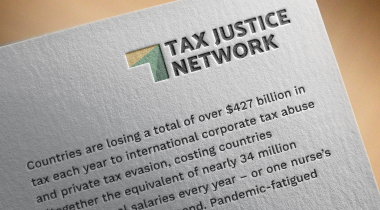
Andres Knobel ■ The IMF’s paper on opaque bank ownership is fully aligned with our beneficial ownership policies

Beneficial ownership transparency is a crucial tool to fight illicit financial flows. It involves identifying the real individuals who ultimately own, control or benefit from legal vehicles such as companies and trusts. Although this sounds rather simple, getting it right is a whole different story. Standards by international organisations (watered down by powerful countries) tend to be quite weak and unambitious. Even then, countries fail to meet these low standards as they lack understanding, resources or interest (or all of the above).
Against this gloomy context, a technical note published by the IMF in January 2024 on “Resolving Opaque Bank Ownership and Related-Party Exposures” is a much welcomed breath of fresh air. It is also an encouraging sign of what the IMF’s new AML strategy is capable of. The technical note deals with an issue very dear to the Tax Justice Network on who “controls the controllers”. Financial institutions are frequently bestowed with obligations to prevent money laundering, determine the tax residence of account holders, withhold account holders’ taxes or report their banking information for automatic exchange purposes. However, this system which relies on the private sector to self-supervise and to assist competent authorities often results in awful consequences (as can be expected of any system with the wrong incentives). For instance, there have been several cases of banks turning out to be complicit, or even initiators, of the wrongdoing they are meant to guard against. The Swiss leaks is one prominent example.
The IMF technical note is not just interesting for its subject matter. It also made us here at the Tax Justice Network realise that we need to update our paper on uses and purposes of beneficial ownership data to include another very important reason to provide public access to beneficial ownership information: bank stability and bank failure. Lack of beneficial ownership transparency can have an impact on the (illegal) transactions carried out by the bank’s owners, which in turn can have serious financial stability and macroeconomics effects for a country. As the technical note describes:
“If not managed properly, related-party transactions can quickly become a source of bank weakness and a threat to financial stability…Most of these [bank] failures (16 out of 22) were largely attributed to extensive abuses by beneficial owners of bank resources in a manner affecting viability….In Indonesia, excessive related-party exposures were one of the key contributors to the country’s banking crisis in the late 1990s… the channeling of funds to finance beneficial owners was a common practice” (pp. 22 and 34).
Some could argue that if public access to beneficial ownership information is needed to prevent bank failures, then it should only apply to the banking sector rather than generally. However, the same counter-argument (that we’ve repeated many times) applies: if you don’t cover absolutely all companies, then secrecy (for corruption, fraud or bank failure) will move up the chain, to the contractor or supplier. Indeed, the same happens with banks where secrecy is not present in the bank itself, but in the secretive entities engaging in (undisclosed) related-party transactions:
“[…] the experience of some jurisdictions with material related-party problems shows that although the banks’ immediate related parties, such as managers or controlling shareholders, were mostly known to the authorities, numerous borrowing entities that were de facto connected to these related parties were not reported as such.” (P. 26)
Apart from offering us a new purpose and case for public access to beneficial ownership, the technical note offers several recommendations that are completely aligned with the Tax Justice Network’s position on beneficial ownership transparency. The following table presents a summary of our papers and proposals compared to extracts from the technical note pointing to the same ideas.
The Tax Justice Network’s proposals compared to the IMF paper’s proposals
| The Tax Justice Network | IMF technical note on banking ownership (extracts) |
|---|---|
| As proposed for instance by our roadmap to effective beneficial ownership transparency (REBOT), all countries should establish public access to beneficial ownership information. We have published a report addressing the privacy, data protection and human rights perspective in favour of public access to beneficial ownership information. | “It is good practice to require public disclosure of a bank’s beneficial owners.” (p. 9) |
| Our paper Complex ownership structures: addressing the risks for beneficial ownership transparency explores long ownership chains, and shows how using entities in secrecy jurisdictions and trusts are the most sophisticated ways to hide beneficial ownership. | “Common characteristics of opaque ownership structures include (1) excessive layers of ownership (for example, chains of holding companies)… (2) owners’ residency in foreign jurisdictions… (3) complex usage of available legal persons and arrangements (for example, special purpose vehicles, trusts).” (p. 9) |
| Our paper Why beneficial ownership frameworks aren’t working deals mainly with the problems of a narrow approach in the beneficial ownership definition, and particularly the use of thresholds.Our paper Beneficial ownership definitions: determining “control” unrelated to ownership demonstrates how beneficial owners can control an entity without holding any shares in it. | “A common problem relates to narrow or unclear definitions of … “significant ownership,” or other relevant terms; for example, exclusively based on quantitative indicators such as ownership thresholds. Definitions may fail to capture voting rights being exercised without legal ownership (for example, under a collateral arrangement) or preferential voting rights (for example, veto rights).” (p.11) |
| Some of our policies in our roadmap focus on addressing complex ownership structures and incentivising compliance go way beyond international standards. These include proposals to reduce the number of allowed ownership layers, lowering (or eliminating) thresholds, prohibiting discretionary trusts, disallowing foreign entities based in secrecy jurisdictions from owning local assets or entities, and applying the “constitutive effect” so that registration is a pre-condition for having or exercising rights. | Additional legal amendments, beyond international standards, may need to be considered… examples of enhancements include (1) restricting the complexity of bank ownership, for example, by limiting the number of ownership layers; (2) lowering the threshold for direct and indirect “significant ownership,” to enable the supervisor to deal with opaque ownership structures and concerted actions that were designed to keep the relative share of individual shareholders just below preexisting regulatory thresholds… that full disclosure of beneficial ownership.… is a precondition for exercising their shareholder rights;… (6) explicitly empowering the supervisor to declare a specific ownership structure as “nontransparent” and, thus, in breach of licensing requirements; (7) explicitly stipulating in law that bank owners or shareholders from jurisdictions that are uncooperative for the purposes of prudential supervision, or are considered to have strategic AML/CFT deficiencies, do not meet suitability requirements” (p. 11 and 13) |
| Our roadmap together with our papers on trust registration around the world and abuses of offshore trusts describe the risks of trusts (especially discretionary trusts) and propose ways to disallow them or counter their harmful effects.Our roadmap and paper on why beneficial ownership registries aren’t working also recommend identifying those with a power of attorney as beneficial owners with control.One of our first papers on beneficial ownership, published back in 2016, proposed identifying the 10 or 20 biggest shareholders in cases where no individual passes the threshold to become a beneficial owner (instead of following the Financial Action Task Force’s requirement to identify a senior manager). | Box 3 on Ukraine’s indicators on non-transparent ownership:“* Trust: Presence of a discretionary trust in the ownership structures* Power of attorney: Issuance of power of attorney…* … For shareholder structures with more than 20 natural persons, the largest 20 individual shareholders were defined as ‘key participants.’” (p. 12) |
| Our paper Rethinking limited liability: beneficial ownership transparency to reform the liability system proposed ways to ensure beneficial owners or ultimate shareholders are held liable. This liability should also apply to any earnings that shareholders, beneficial owners or directors obtained from the company, even if they are no longer related to the entity by the time the liability arises (within some reasonable timeframe). In other words, if John as a shareholder got dividends worth $10 million from company A, then sold his shares to Mary and after a few months company A cannot repay its debt, then at least part of $10 million previously paid out to John should be used to repay current creditors, even if John is no longer a shareholder or beneficial owner. In essence, if there’s a cap in losses, there should be a cap in gains. | “The civil liability of beneficial owners and other related parties for a bank’s failure may be based on a combination of general and specific rules. The bank can pursue its claims from related parties on different legal grounds, for example, contract, tort, or unjust enrichment.” (p. 35) |
| Our roadmap as well as our paper on beneficial ownership verification proposes sophisticated checks to detect registered owners who are actually nominees serving as owners. These checks include checking whether the registered owner could have afforded acquiring their shares to begin with, based on their declared income or wealth.Likewise, our paper on complex ownership structures recommended reversing the cost equation. As things stand now, complexity is free for those who create it and costly for authorities and investigators who seek to identify the beneficial owner hiding behind the complicity – a task that often proves impossible. Our recommendation was to reverse this situation, and make it costly and burdensome (or even forbidden) to create complex ownership structures. This would be similar to how Dutch banks started charging higher fees to customers with complex ownership structures because of the extra costs the banks incurred when performing due diligence. | “verify that beneficial owners have no record of criminal activities or involvement in illicit activities or suspicious practices. It should also assess their financial soundness, that is, the sources of funds for the acquisition of bank shares… The financial soundness assessment is a key tool to identify potential “strawmen” (that is, nominal shareholders that lack financial strength and act in the interest of an undisclosed beneficial owner). In jurisdictions with legacy opaque shareholder structures of systemic proportions, this assessment may call for identified beneficial owners to submit audited financial statements, tax returns, bank account statements, independent personal asset valuations, and other documents.” (p. 16) |
| Our paper on beneficial ownership verification delves into the risks and challenges of verifying beneficial ownership information and proposes various methods for verifying that information and detecting red flags. One challenging example is detecting cases where trusts disguise distributions to beneficiaries (eg paying their tuition fees or credit card expenses) as if they were expenses belonging to the trust. The IMF paper proposes additional, very good ideas on how to detect undisclosed relationships between entities and how to identify nominees and shell companies. | “*Exclusivity: For example, no other financial institution unrelated to the bank is lending to the party, and the amount and type of loans do not justify it from an economic point of view. *Economic dependency: For example, most of the party’s revenues come from the bank or its related parties … *Common infrastructure: For example, common or very close business addresses (physical or virtual) with the bank and its related parties; common operational structural elements; common managers or staff; and common suppliers, service providers, or customers. *Underwriting standards: For example, material disproportion between proceeds, tenor, and terms and conditions; legal form of transaction differs from their economic essence; and the terms and repayment conditions differ from the current market conditions. (…) *Indebtedness and creditworthiness: For example, at the onset, the loan is unlikely to be repaid as stipulated in the contract, given creditworthiness and available repayment sources; and credit rating below the minimum considered acceptable by the bank. *Interest rates, fees, and prices: For example, interest rate and fees to be paid to the bank are substantially lower than for clients with similar economic and financial characteristics, and prices paid by the bank for assets or received services differ from market prices. (p. 27)*Loan transactions in the weeks prior to material capital injections (for example, those exceeding a certain percentage of total capital during the past five years) should also be reviewed to ensure that the injections have not been effectively funded by the bank itself. *The sample should also include some transactions that do not directly involve credit exposures, for example, purchase and sale of financial instru¬ments and nonfinancial assets, acquisition of assets in lieu of loan repayment, and service contracts, such as for asset management, advice, and other major professional services (for example, information tech-nology development, database management, auditing, and loan workouts).” (p. 30) |
Conclusion
This technical note is an excellent example of the role that the IMF can and should take to bring about real progress on beneficial ownership transparency. For instance, the IMF could start requesting major financial centres to publish beneficial ownership information of their banking sector. This would allow beneficial ownership transparency to move beyond the weak international standard set by the Financial Action Task Force. We hope to see more of this ambitious approach when the IMF engages with countries on capacity building and financing, and when the IMF give feedback on current international standards. In this regard, a protocol on beneficial ownership transparency to the UN Framework Convention on International Tax Cooperation (the UN Tax Convention) would also ensure more transparency for all countries.
Related articles

2025: The year tax justice became part of the world’s problem-solving infrastructure
One-page policy briefs: ABC policy reforms and human rights in the UN tax convention

The Financial Secrecy Index, a cherished tool for policy research across the globe

When AI runs a company, who is the beneficial owner?
Insights from the United Kingdom’s People with Significant Control register
13 May 2025

Uncovering hidden power in the UK’s PSC Register

New article explores why the fight for beneficial ownership transparency isn’t over
Asset beneficial ownership – Enforcing wealth tax & other positive spillover effects
4 March 2025

Tax Justice transformational moments of 2024


